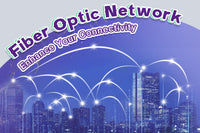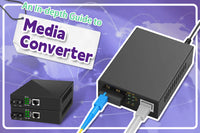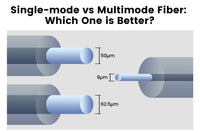The optical network plays an important role in enabling reliable and efficient communication in modern network systems. A typical fiber optic network includes fiber optic cables, fiber connectors, media converters, wavelength division multiplexers (WDN), and optical transceivers. This article provides an exploration of optical transceivers, covering their structure, working principles, functions, types, and applications.
What are Optical Transceivers?
The optical transceiver, also simply known as an optical module or fiber optic transceiver, is an integration of a transmitter and receiver within a single module. It can convert light to electrical signals or vice versa, enabling seamless communications via routers or switches. It has an electrical interface at one end for transmitting electrical signals within the system and an optical interface at the other end to connect other devices via fiber optic cables.
Optical transceivers come in various types, including transceivers embedded into a device, non-hot-swappable transceivers, and hot-pluggable transceivers. They are widely used in FTTH, FTTB, wireless networks, mobile communication networks, SAN/NAS storage networks, data centers, and other applications.
The Structure of Optical Transceivers
Optical transceivers feature complex structures and come in different types. Here we give a brief introduction of the basic components.
- Transmitter Component: The light emitting component, known as TOSA, is designed to convert electrical signals into light pulses. The light core generally uses laser diodes (LDs) or light-emitting diodes (LEDs). But nowadays, most optical transceivers use LDs to reduce power consumption.
- Receiver Component: The optical receiving component or ROSA usually includes a semiconductor photodetector, the optical receiving interface, and the electrical interface. ROSA receives and converts the light pulses to electrical signals. It may also contain a trans-impedance amplifier (TIA) to convert the electrical signal into a voltage signal and amplify and equalize the signal.
- Housing: The housing comes in different types and protects the interior components.
- Latch: It is a mechanical component designed to ensure reliable connectivity between optical modules and other devices like routers and switches. The latch can vary depending on different fiber transceivers and different connected devices.
- Dust Plug: The dust cap protects interfaces and internal components from environmental contamination and physical damage.

How Does an Optical Transceiver Work?
The optical transceiver is essential in fiber optic communication for transmitting and receiving data. In electrical-to-optical conversion, the optical transceiver receives the electrical signal from devices. The transmitter, equipped with a laser diode, helps convert these electrical signals into optical pulses. Before transmitting, the data modulates the intensity of the laser light and encodes the data into optical signals. In optical-to-electrical conversion, the optical signals are detected and decoded into electrical signals by the photodetector.

Fiber Optic Transceiver Types
Fiber optic transceivers come in various types. They can also be categorized based on form factors, fiber types, and wavelength. We mainly focus on the following 3 ways to divide fiber transceiver types.
Classified by Form Factor
The form factor indicates the shape, size, and structure of an optical transceiver. Different form factors are designed to support varying speeds and protocols. Organizations such as the Institute of Electrical and Electronics Engineers (IEEE) and Multisource Agreement (MSA) standardize specifications for those form factors to ensure the compatibility and interoperability of optical transceivers. Here is an introduction to some common optical transceivers based on different form factors.
- GBIC (Gigabit Interface Converter)
Defined in 1995, GBIC or Gigabit Interface Converter was once popular, supporting gigabit speeds and offering the hot-swappable function. However, due to its outdated transmission rates and large size, GBICs are no longer used in modern devices and have been replaced by SFPs.
- SFP (Small Form-Factor Pluggable)
Introduced in 2001, Small Form-Factor Pluggable (SFP) is a widely adopted form factor. The SFP module, being half the size of the GBIC transceiver, is ideal for high-density ports. It has a typical speed of 4.25 Gbit/s, which is widely used in Gigabit Ethernet and other network applications.
- SFP+ (Enhanced Small Form-Factor Pluggable)
SFP+ was first published in 2006, with an enhanced form factor compared to STP transceivers. Based on SFF-8431, SFP+ can support a data rate of up to 10 Gbit/s.
- QSFP+ (Quad Small Form-Factor Pluggable Plus)
Launched in 2012, QSFP+ is an upgraded version of the Quad Small Form Factor Pluggable transceiver. QSFP+ can support the data rate of up to 40 Gbit/s.
- CFP (C Form-Factor Pluggable)
Released in 2009, the C Form Factor Pluggable (CFP) transceiver is designed for 100 Gigabit Ethernet systems. CFP transceivers are larger than SFP and QSFP+, aiming to provide high-speed data signals over long-distance data transmission.
Classified by Fiber Types
Single-mode and multimode are the two basic fiber types. Optical transceivers can also be divided into single-mode and multimode types.
Single-mode transceivers are designed for single-mode fiber optic cables. They can transmit data over tens or even more than one hundred kilometers. These optical transceivers typically operate at wavelengths of 1310 nm, 1490 nm, or 1550 nm.
Multimode transceivers, used with multimode fiber optic cables, can operate at a typical center wavelength of 850 nm. Most multimode transceivers do not have a transmission distance of more than 550 m, but they are the best choice for cost-effective short-distance data transmission.
Classified by Wavelength Types
Standard optical transceivers typically transmit data at three wavelengths, including 850 nm, 1310 nm, or 1550 nm. These optical transceivers only use one wavelength of light and are commonly referred to as grey transceivers. They are widely compatible with various network environments. Based on wavelength-division multiplexing (WDM) types, optical transceivers can be divided into different types, such as Coarse Wavelength Division Multiplexing (CWDM), and Dense Wavelength Division Multiplexing (DWDM) transceivers. These optical transceivers use multiple center wavelengths of light. They are typical color transceivers providing higher bandwidth capacity and longer transmission distances. It is important to note that the term “color” refers to wavelength, not the physical color of the latch.
Notes: A rich specification information can be obtained from the model name of an optical transceiver. A typical optical transceiver model contains at least form factor, rate, and distance type information, such as SFP-10G-SR and 1000Base-LX-SFP.
Different letters are used to indicate the transmission distance types, such as SR (short range)/LR (long range)/ER (extended range) and SX (short distance)/LX (medium distance) /LH (long distance).
Other information in the naming may include transfer modes (SM for single-mode and MM for multimode), center wavelengths in nm (850, 1310, 1550), transmission distance, and the number of optical lanes.
Conclusion
Optical transceivers are critical components in network infrastructures. With the development of fiber optic networks and the growing demand for high-speed, high-bandwidth networks, optical transceivers are expected to feature more compact and flexible designs, enhanced data rates, improved power efficiency, and extended range capabilities.
FAQs
Can I connect a single-mode optical transceiver with a multimode transceiver?
Generally, no. Single-mode and multimode optical transceivers operate at different wavelengths and are designed for single-mode and multimode optical fibers respectively.
What is the difference between optical transceivers and media converters?
Despite their similar functions, optical transceivers and media converters play different roles. Optical transceivers are specialized for fiber optic links, converting optical signals to electrical signals and vice versa; media converters bridge the gap between different media types, such as copper and fiber cables, thereby extending network reach.
Can I clean the optical transceiver?
Yes, when optical transceivers become contaminated, you can clean them with lint-free cotton swabs, an optical cleaning solution, and clean dry air.
For more information on this topic, you can keep up on our blogs. While VCELINK offers general and basic information for our customers and other visitors to the website, it’s not professional advice.



Be the first one to comment.
Leave a comment